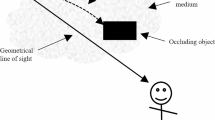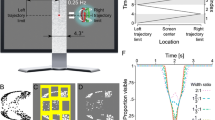Summary
Kellman and Shipley (1991) recently advanced a new theory to explain the perception of partly occluded objects and illusory figures. The theory is a formalization of the Gestalt law of good continuation. In this paper we describe their account of occlusion when the contour of the occluded is completely specified by a display. Next, we outline some critical objections and present a number of counterexamples. Finally, we compare their theory with Wouterlood and Boselie's (in this issue) model of occlusion phenomena, which might also be considered as a formalization of the law of good continuation.
Similar content being viewed by others
References
Arnheim, R. (1971).Art and visual perception. Berkeley: University of California Press.
Boselie, F. (1988). Local versus global minima in visual pattern completion.Perception & Psychophysics, 43, 431–445.
Boselie, F., & Wouterlood, D. (1989). The minimum principle and visual pattern completion.Psychological Research, 51, 93–101.
Buffart, H., Leeuwenberg, E., & Restle, F. (1981). Coding theory of visual pattern completion.Journal of Experimental Psychology: Human Perception and Performance, 7, 241–274.
Chapanis, A., & McCleary, R. (1953). Interposition as a cue for the perception of relative distance.Journal of General Psychology, 48, 113–132.
Dinnerstein, D., & Wertheimer, M. (1957). Some determinants of phenomenal overlapping.American Journal of Psychology, 70, 21–37.
Durlinger, K. (1989). Achtergrondvorm of voorgrondvorm? Een locale factor onderzocht. Unpublished master thesis, University of Nijmegen.
Gerbino, W. (1989). Form categorization and amodal completion.Acta Psychologica, 72, 295–300.
Gerbino, W., & Salmaso, D. (1987). The effect of amodal completion on visual matching.Acta Psychologica, 65, 25–46.
Helmholtz, H. Von (1866, 1925).Physiological optics Vol. III. Optical Society of America.
Kanizsa, G., & Gerbino, W. (1982). Amodal completion: seeing or thinking? In: J. Beek (Ed.),Organization and representation in perception (pp. 167–190). Hillsdale, NJ: Erlbaum.
Kellman, P. J., & Shipley, T. F. (1991). A theory of visual interpolation in object perception.Cognitive Psychology, 23, 141–221.
Koffka, K. (1935).Principles of Gestalt psychology. London: Routledge & Kegan Paul.
Leeuwenberg, E. & Van der Helm, P. (1991). Unity and variety in visual form.Perception, 20, 595–622.
Ratoosh, P. (1949). On interposition as a cue for the perception of distance.Proceedings of the National Academy of Science, 35, 257–259.
Shipley, T. F., & Kellman, P. J. (1992). Perception of partly occluded objects and illusory figures: evidence for an identity hypothesis.Journal of Experimental Psychology: Human Perception and Performance, 18, 106–120.
Wouterlood, D. & Boselie, F. (in this issue). A good-continuation model of some occlusion phenomena. Psychological Research.
Author information
Authors and Affiliations
Rights and permissions
About this article
Cite this article
Boselie, F., Wouterlood, D. A critical discussion of Kellman and Shipley's (1991) theory of occlusion phenomena. Psychol. Res 54, 278–285 (1992). https://doi.org/10.1007/BF01358265
Received:
Accepted:
Issue Date:
DOI: https://doi.org/10.1007/BF01358265




